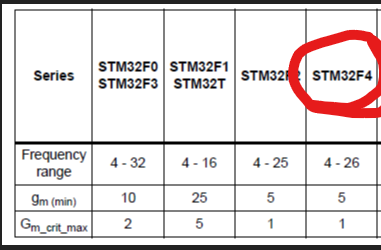The parameters in the picture you posted are not parameters of the crystal. They are the parameters of the STM32 built-in oscillator, namely transconductance, and the critical limit the crystal circuit must not require for good operation. That is why you can't find crystals with those parameters. But you will need parameters of both devices to find out if they are compatible or not.
With the parameters of both the crystal and MCU, and the equations in the appnote, you can calculate if the gain margin is larger than 5, which is a generally accepted safe value that the crystal and oscillator work together.
Basically the equations say that higher frequency, higher load capacitance rating, and higher ESR rating of the crystal need more transconductance from the oscillator to work, so all those bring down the gain margin.
To put it another way, lower frequency, lower load capacitance rating, and lower ESR rating make it easier to achieve good gain margin.
In your case, if you don't have any specific need (such as Ethernet or some audio master clock) to use exactly 25 MHz crystal, I suggest to use lower frequency crystal like for example 8 MHz. These may come in slightly larger packages than the 25 MHz crystals. Since you want 100 MHz CPU frequency, you must use the PLL, and the crystal frequency must be prescaled down to the 1 MHz to 2 MHz range before it is fed to the the PLL input. So the PLL does not know if the 1 MHz was 25 MHz divided by 25, or 8 MHz divided by 8.

